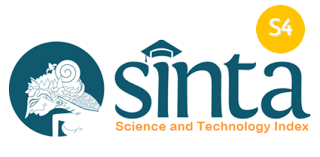RANCANG BANGUN ALAT PEMANTAU KUALITAS UDARA DENGAN PEMANFAATAN IoT (INTERNET OF THINGS) BERBASIS MIKROKONTROLER MENGGUNAKAN SENSOR MQ-135 DAN MQ-136 PADA WILAYAH KABUPATEN PONOROGO (PARAMETER CO2 DAN SO2)
Main Article Content
Abstract
This study uses an Arduino Uno-based IoT air monitoring device with MQ-135 sensor and MQ-136 sensor. Arduino Uno is a microcontroller board based on ATmega328 (datasheet). It has 14 input pins of digital output where 6 of them can be used as PWM output and 6 analog input pins, 16 MHz crystal oscillator, USB connection, power jack, ICSP header, and reset button. To support the microcontroller to be used, the Arduino Uno Board is connected to a computer using a USB cable or electricity with an AC-to-DC adapter or battery to run it. The MQ-135 sensor type is one of the sensors that can detect CO2 gas levels. This sensor has low conductivity when placed in clean air. Then the MQ-136 sensor type is a sensor that has high sensitivity to SO2 gas, this sensor can also be used to detect other vapors containing sulfur gas. In both sensors there is a resistance value (Rs) that can change when exposed to gas and also a heater that is used to clean the sensor room from outside air contamination. The output of the two sensors is in the form of analog data. The ESP8266 is a Wi-Fi Smart on Chip (SoC) that is designed to be minimalist in size and uses very little external circuitry. The chip can communicate over wifi infrastructure using IPv4, TCP/IP, and HTTP protocols. The results of the MQ-135 and MQ-136 sensor readings on the microcontroller device show quite good values and also meet the existing quality standards. The MQ-135 sensor for CO2 gas readings has an average result of 314 ppm. The MQ-136 sensor for SO2 gas readings has an average value of 0.015 ppm. The working system on Android that is used uses the Blynk Apps application by making coding for LCD, LED, buzzer, and sensors that are connected to smartphones via wireless. The use of the value feature as real-time data has been able to monitor and provide air quality notifications via smartphone or email.
Downloads
Article Details
Submission of a manuscript to Jurnal Purifikasi means that the work has never been published in another journal and is not under consideration for publication elsewhere. The author hereby agrees to submit the copyright of the manuscript and its contents to Jurnal Purifikasi, if accepted for publication. Accepted manuscripts will be published in printed form where the ISSN is bound in printed form, not in online form (pdf). Authors are not allowed to publish their work in other forms (journals) without permission from the Jurnal Purifikasi manager.
By submitting a manuscript, the author is deemed to know all the rights and obligations attached to each manuscript.








